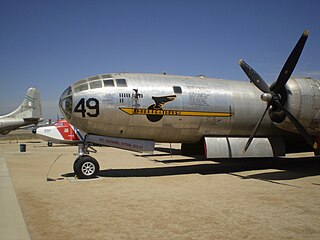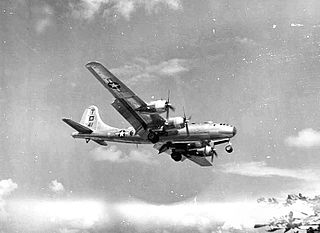
The 497th Air Expeditionary Group is a provisional United States Air Force unit. It is assigned to Pacific Air Forces to activate or inactivate as needed.

The 73d Air Division is an inactive United States Air Force unit. Its last assignment was with Air Defense Command at Tyndall Air Force Base, Florida, where it was inactivated on 1 April 1966.

The 768th Bombardment Squadron is an inactive United States Air Force unit. It was last assigned to the 462d Strategic Aerospace Wing at Larson Air Force Base, Washington, where it was inactivated on 25 June 1966. The squadron was first activated in 1943, and became one of the earliest Boeing B-29 Superfortress units. It moved to the China Burma India Theater in April 1944 and participated in the first attack on the Japanese Home Islands since the 1942 Doolittle Raid on 15 June 1944. It earned three Distinguished Unit Citations. The squadron moved to Tinian with the rest of the 58th Bombardment Wing in April 1945 and continued its participation in the strategic bombing campaign against Japan until V-J Day. In November 1945, it returned to the United States, where it was inactivated in April 1946.
The 771st Bombardment Squadron is a former United States Army Air Forces unit. The squadron was activated in 1943, and became one of the earliest Boeing B-29 Superfortress units. It moved to the China Burma India Theater in April 1944 and participated in the first attack on the Japanese Home Islands since the 1942 Doolittle Raid in June 1944. In August 1944, it earned a Distinguished Unit Citation. It was inactivated on 12 October 1944, when the Army Air Forces reorganized its very heavy bomber groups to consist of three, rather than four squadrons.

The 497th Bombardment Group was a group of the United States Army Air Forces. The unit was inactivated on 31 March 1946.

The 874th Tactical Missile Squadron is an inactive United States Air Force unit. Its last assignment was with 498th Tactical Missile Group at Kadena Air Base, Okinawa. The squadron was first activated in late 1943 for service during World War II as the 874th Bombardment Squadron. After training in the United States with Boeing B-29 Superfortress bombers, the squadron moved to the Mariana Islands, where it participated in the strategic bombing campaign against Japan, earning two Distinguished Unit Citations before the end of hostilities in August 1945. The squadron returned to the United States in December 1945 and was inactivated in March 1946, and its personnel and equipment transferred to another organization.

The 352d Bombardment Squadron is an inactive United States Air Force unit. It was last assigned to the 301st Bombardment Wing at Lockbourne Air Force Base, Ohio, where it was inactivated on 8 June 1964.

The 787th Air Expeditionary Squadron is a provisional United States Air Force unit, assigned to United States Air Forces Europe. The squadron has been activated twice for contingency operations in Africa.

The 883d Bombardment Squadron is a former United States Army Air Forces unit. It was organized in November 1943 and, after training in the United States, deployed to the Pacific Ocean Theater of World War II, where it participated in the strategic bombing campaign against Japan. It earned two Distinguished Unit Citations before the end of the war. It returned to the United States in the fall of 1945 and was inactivated at March Field, California in January 1946.

The 878th Bombardment Squadron is a former United States Army Air Forces unit. It was activated in November 1943, equipped with Boeing B-29 Superfortress bombers, and assigned to the 499th Bombardment Group. After training in the United States, it deployed to Saipan, where it participated in the strategic bombing campaign against Japan, earning two Distinguished Unit Citations. After V-J Day, it returned to the United States, where it was inactivated at March Field, California on 16 February 1946.

The 421st Air Refueling Squadron is an inactive United States Air Force unit. It was last assigned to the 41st Air Division at Yokota Air Base, Japan, where it was inactivated on 18 February 1965.

The 872nd Bombardment Squadron is the former name of the 872nd Air Expeditionary Squadron, a provisional unit of the United States Air Force. It is assigned to United States Air Forces Europe to activate or inactivate as needed.

The 793d Bombardment Squadron is a former United States Army Air Forces unit. The squadron was organized in 1943 as one of the first Boeing B-29 Superfortress units. After training in the United States, The squadron moved to India and participated in the strategic bombing campaign against Japan. When bases in the Mariana Islands became available, the squadron moved to Tinian, where it was able to strike targets in Japan without staging through forward bases. It earned three Distinguished Unit Citations during its combat tour. It returned to the United States following V-J Day and briefly became one of the first units in Strategic Air Command before inactivating at the end of March 1946.

The 870th Bombardment Squadron is a former United States Army Air Forces unit. It was assigned to the 497th Bombardment Group, and was last stationed at MacDill Field, Florida where it was inactivated on 31 March 1946. The squadron was activated in late 1943. After training in the United States, it moved to Saipan in the Central Pacific Area, where it served in the strategic bombing campaign against Japan with Twentieth Air Force, flying Boeing B-29 Superfortress aircraft, where it earned two Distinguished Unit Citations. Following V-J Day, the squadron returned to the United States and briefly became part of Strategic Air Command before inactivating.

The 871st Bombardment Squadron is an inactive United States Air Force unit. During World War II it was assigned to the 497th Bombardment Group until it was inactivated on 31 March 1946. The squadron was activated in late 1943. After training in the United States, it moved to Saipan, where it served in the strategic bombing campaign against Japan with Twentieth Air Force, flying Boeing B-29 Superfortress aircraft in the Pacific Theater of Operations, where it earned two Distinguished Unit Citations. Following V-J Day, the squadron returned to the United States and briefly became part of Strategic Air Command before inactivating.

The 875th Bombardment Squadron is a former United States Army Air Forces unit. The squadron was activated in late 1943 for service during World War II. After training in the United States with Boeing B-29 Superfortress bombers, the squadron moved to the Mariana Islands, where it participated in the strategic bombing campaign against Japan, earning two Distinguished Unit Citations before the end of hostilities in August 1945. The squadron returned to the United states in December 1945 and was inactivated in March 1946, and its personnel and equipment transferred to another organization.

The 788th Tactical Fighter Squadron is an inactive United States Air Force unit. During World War II, as the 788th Bombardment Squadron, it was assigned to the 467th Bombardment Group as a Consolidated B-24 Liberator squadron in 1943. After training in the United States, it moved to the European Theater of Operations the following year. It saw combat until the surrender of Germany in May 1945, earning a French Croix de Guerre with Palm for its actions contributing to the liberation of France. From May to August 1944, the squadron was detached to the 801st Bombardment Group (Provisional) engaging in Operation Carpetbagger operations. After V-E Day, the squadron returned to the United States and transitioned into the Boeing B-29 Superfortress It was inactivated on 4 August 1946 at Clovis Army Air Field, New Mexico.

The 789th Tactical Fighter Squadron is an inactive United States Air Force unit. During World War II, as the 789th Bombardment Squadron, it was assigned to the 467th Bombardment Group as a Consolidated B-24 Liberator squadron in 1943. After training in the United States, it moved to the European Theater of Operations the following year, where it participated in the strategic bombing campaign against Germany. It saw combat until the surrender of Germany in May 1945. After V-E Day, the squadron returned to the United States and transitioned into the Boeing B-29 Superfortress It was inactivated on 4 August 1946 at Clovis Army Air Field, New Mexico.

The 790th Bombardment Squadron is a former United States Army Air Forces unit, established as a Consolidated B-24 Liberator squadron in 1943. After training in the United States, it moved to the European Theater of Operations the following year. During World War II it was assigned to the 467th Bombardment Group, and engaged in the strategic bombing campaign against Germany. After V-E Day, the squadron returned to the United States and transitioned into the Boeing B-29 Superfortress. It was inactivated on 4 August 1946 at Clovis Army Air Field, New Mexico in March 1946 and its resources were transferred to another unit.

The 791st Bombardment Squadron is a former United States Army Air Forces unit. During World War II it was assigned to the 467th Bombardment Group, and engaged in the strategic bombing campaign against Germany. After V-E Day, the squadron returned to the United States and transitioned into the Boeing B-29 Superfortress. It was inactivated on 31 March 1946 at Roswell Army Air Field, New Mexico in March 1946 and its resources were transferred elsewhere.






















